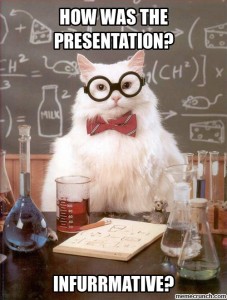This is the post for the Wednesday, April 29, 2015 class meeting.
 I’m still grading Project 3. Remember that I will not update the blog posts or attendance totals until after class on May 6.
I’m still grading Project 3. Remember that I will not update the blog posts or attendance totals until after class on May 6.
Presentations
10:10 class presentations will be from these folks:
- 10:15: Erica P
- 10:22: Sarah B (project)
- 10:29: Meron K
- 10:36: Daniel N
- 10:43: Miranda M
- 10:50: Anna H (Slideshare backup)
11:15 class presentations will be from these folks:
Remaining To-Do’s
-
If you have a zero in Scholar, submit your work for Projects 1, 2, or 3 by 11:55 PM on Wednesday, 4/29. Otherwise the zero will stand.
-
If you are presenting Friday, email me the link to your presentation by midnight on Thursday (no grace period) so that I can set up the post for class
-
Complete the SPOT survey if you haven’t yet.
-
Submit your remix by 11:55 PM on Wednesday, May 6, 2015, following the instructions posted Monday.
-
Take the final exam. If your work is not submitted by 11:55 PM on Monday, May 11, you will receive a zero.








